This March I attended the annual meeting of the American Association for the
Advancement of Science (2017) in Boston. The theme of the conference was “Serving
Society Through Science Policy,” and many of the featured panels and speakers
focused on how to inform policies with the best available scientific evidence.
Connecting with the theme, I presented a poster on my research entitled,
“Framework for Identifying Social-Ecological Hotspots.” Although it is clear that human
and natural systems are inextricably linked across multiple spatial and temporal scales,
the complexities of these interactions can be difficult to assess. Consequently, policy-
makers require information on the vulnerability of both social and ecological systems,
together with rates of change, to identify critical areas. By way of example, this study
provides a framework for identifying global "social-ecological hotspots," where there is a
spatial coincidence of high social vulnerability, high ecological vulnerability, and a high
degree of projected environmental change. I had many good discussions with attendees
throughout the poster session, and felt that my research pitch became more refined.
One of the conference’s keynote speakers, Dr. Naomi Oreskes, was tasked with
applying her background as an environmental historian to ongoing questions at the
science-policy interface, including the role of scientists in the world of politics. I found
her talk entitled “the scientist as sentinel” as particularly germane to my research within
the Department as I consider the limits of integrating science with policy application.
Oreskes argued that scientists have both underrepresented our expertise in the realm of
decision-making (to society’s peril) and over-engaged in the world of politics to the point
of being considered biased and issue-driven. She further purports that scientists are
often reluctant to take on any role other than fact-stating and often emphasize that their
work is “policy relevant” rather than “policy prescriptive.”
As her central point, Oreskes proposed the idea of the “responsible scientist” and
leveraged the examples of multiple scientists including Jim Hansen, Neils Bohr,
Oppenheimer and Einstein to show a range of ways that scientists have engaged
society appropriately and maintained their credibility. Oreskes insists that it is not as
much about the facts, as the implications of the facts that should spur scientists towards
effective communication. In the context of the general public it is appropriate to
acknowledge that Americans are motivated by values and resonate with certain values
more than others. Scientists are also people who are motivated by values, and
connecting our work along those lines is prudent, even as we want our research to
evidence fairness, accountability, realism, creativity, and technological leadership. While
not everyone may feel equipped to engage policy-makers directly, all scientists could
consider way to make their work more relevant to decision-science.
My time at the conference was enriching both personally and professionally. I
hope to attend future AAAS annual meetings, and further explore the world of science
policy.



